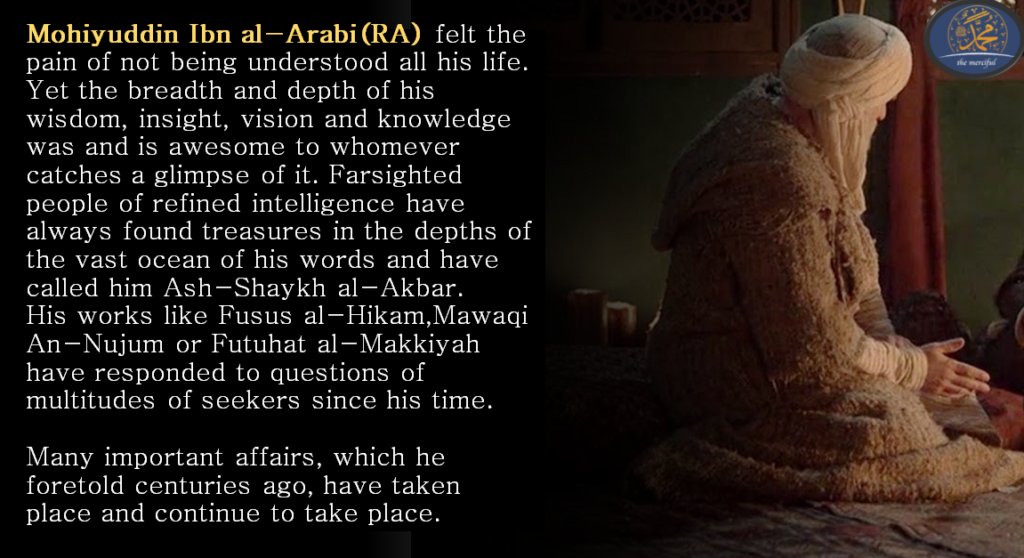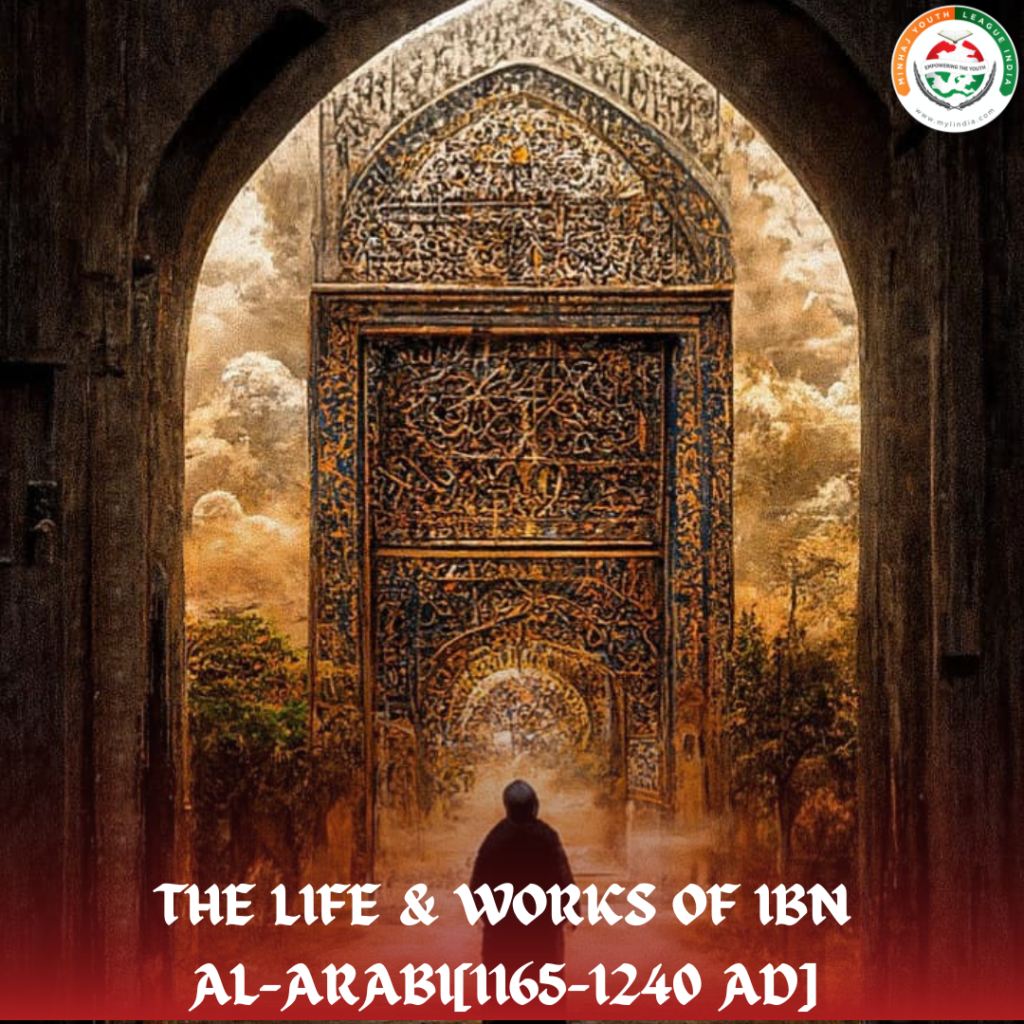𝑴𝒐𝒉𝒊𝒖𝒅𝒅𝒊𝒏 𝑰𝒃𝒏 𝑨𝒍-𝑨𝒓𝒂𝒃𝒊(𝑹𝑨) was born on 17𝒕𝒉 𝑹𝒂𝒎𝒂𝒅𝒂𝒏,560 𝑨𝑯 i.e. July 26,1165 AD in the city of Murcia in Andalusia. His actual name is Muhammad Ibn Ali and he was a descendant of Hatim at-Tai, the legendary model of Arab generosity. Ibn Al-Arabi was a twelfth-century Spanish mystic who has become one of the most important expounders of Sufi wisdom. Farsighted people of refined intelligence have always found treasures in the depths of the vast ocean of his words and have called him Ash-Shaykh al-Akbar(The greatest of spiritual guides). He produced through inspiration perhaps about five hundred books. Many of them are short, about the length of a long article and some like Fusus al-Hikam, Mawaqi An-Nujum, or Futuhat al-Makkiyah are books of many volumes that have responded to questions of multitudes of seekers since his time. His works are like waves in an immense sea containing endless secrets. They are wellsprings of wisdom. Yet there is a great deal of thought in these books that cannot be digested by many intelligent people – even scholars- if their intelligence and knowledge are not supported by pure and believing hearts.
Many important affairs, which he foretold centuries ago, have taken place and continue to take place.
𝐄𝐚𝐫𝐥𝐲 𝐋𝐢𝐟𝐞 𝐚𝐧𝐝 𝐞𝐝𝐮𝐜𝐚𝐭𝐢𝐨𝐧
Mohiyuddin Ibn Al-Arabi(RA)’s father saw the potential in his son early, and when the family moved to the great cultural center of Serville [Spain], he had him thoroughly educated. At eight years of age, he began to study Hadith, Quranic commentary, and Quranic recitation with famous teachers of the time. He also studied the literary arts and physical sciences and associated throughout his youth with many Sufis. At a very tender age, he thus became accomplished in both worldly and religious knowledge. While Mohiyuddin was still a youth, he also made the extraordinary acquaintance of Khidr, a wandering saint sent by Allah to assist his special friends.
𝑯𝒊𝒔 𝑱𝒐𝒖𝒓𝒏𝒆𝒚
In 1201(598 AH), when his father and mother had died, Mohiyuddin ibn al-Arabi left Spain, intending to perform his pilgrimage. He never returned to Spain. The Shaykh’s journey eventually included all of North Africa, the Near East, and Anatolia. He traveled, in fact, to the entire Arabic-speaking world. When Ibn Arabi came to Egypt, he met most of the scholars, wise men, and sages there. The Qutb-cheif saint of the time, was also in Egypt. He has related his encounter with the Qutb in one of his books.Ibn Arabi went on to Mecca, where he stayed for several intensely visionary years. Here he married Fatima bint Yunus, daughter of the Sharif, and fathered a son, Imamuddin who would follow his father and eventually, in 1269(667 AH), share his tomb.
In Mecca, he also began his monumental work, al-Futuhat al-Makkiyah. The Futuhat was a vast compendium of insights and unique symbolic meanings; each of the eight volumes took a calligrapher two years to copy. Despite his deep attraction to the Kaaba, his stay in Mecca was temporarily concluded two years later and he resumed his travels. In the year 1204(601 AH) Ibn Arabi came to Baghdad. He stayed only twelve days. In that brief time, he found and wore the cloak that had been left for him fifty years before by the pivotal Sufi teacher, Shaykh Abdul Qadri Jilani(RA). He met with wise men and sages of Baghdad. He spent another three years on the road, in Mosul and Egypt, before returning to Mecca in 1207(604 AH).
This time he could spend only a year in Mecca before the journey summoned him. He returned to Mosul, proceeded through Malatya and Sivas, and came in 1210(607 AH) to Konya, the political and cultural capital of the Seljuk Empire.
Ibn Arabi came back to Baghdad in 1211(608 AH). Here he encountered another great Sufi Shaykh, Shihabuddin Umar as Suhrawardi. It was around this time that Ibn Arabi’s mystical knowledge reached perfection. From 1213(610 AH) to 1221 (618 AH) he moved from Baghdad to Aleppo, back to Mecca, back to Malatya, and again to Aleppo. During this period, he increasingly encountered envy and misunderstanding, much of which he attempted to disarm. Yet, he also found supporters in high places for example, al-Malik Az-Zakir(Ruler of Aleppo), and al-Malik al-Adil, ruler of Damascus.
𝑯𝒊𝒔 𝒔𝒕𝒂𝒚 𝒊𝒏 𝑫𝒂𝒎𝒂𝒔𝒄𝒖𝒔
When in 1223(620 AH) al-Adil implored him to settle in his city, he accepted. Except for a brief visit to Aleppo, he would remain in Damascus for thirty years. Since the event is said to have occurred in 1223(620 AH), it must have been in Damascus that Ibn Arabi met a young man who would become another Sufi of universal scope and appeal, Mevlana Jalaluddin Rumi.
Not all of the Shaykh’s encounters in Damascus were happy ones. Many of the scholars and theologians there, as elsewhere, envied and hated him-not least because he had the favor of the prince and his highest officials. Their claim, though, was always that his religion was suspect. In his turn, Ibn Arabi was none too fond of the scholars of Damascus, but their opposition to him was not the reason. He disliked them because they sold their knowledge for profit, and that money had become a veil preventing them from seeing the Truth. He hated money, and he hated the people who made money their God.

𝑷𝒂𝒔𝒔𝒊𝒏𝒈 𝑨𝒘𝒂𝒚
One day in Damascus he saw an Imam- a lover of money – leading a whole congregation of people who also had the love of money in their hearts. He called to them from the door, saying ,”I am treading the God you worship; he is under my feet!” The congregation began to curse and beat him. Some say he passed away from the wounds he received on this occasion. He left this world on the night of Friday (Jumuah), 28th Rabi uth-Thani in 638 AH[1240 AH].He was seventy-six years old. His funeral was presided over by the Qadi of Damascus, and he was buried in the quarter of Salihiyah.
CHAINS OF NARRATION OF IBN AL-ARABI(RA)
Shaykh Akbar Mohiyuddin-Ibn al-Arabi(RA) felt the pain of not being understood all his life. Yet the breadth and depth of his wisdom, insight, vision, and knowledge was and is awesome to whoever catches a glimpse of it. His words are like waves in an immense sea containing endless secrets. He produced through inspiration perhaps about five hundred books. Many of them are short, about the length of a long article and some like Fusus al-Hikam, Mawaqi An-Nujum, or Futuhat al-Makkiyah are books of many volumes that have responded to questions of multitudes of seekers since his time. They are wellsprings of wisdom. Yet there is a great deal of thought in these books that cannot be digested by many intelligent people – even scholars- if their intelligence and knowledge are not supported by pure and believing hearts.
Many important affairs, which he foretold centuries ago, have taken place and continue to take place.
Shaykh Al-Akbar Mohiyuddin Ibn Arabi(RA) was a great scholar and a muhaddith.
-He studied knowledge of hadith from 70 prominent scholars from Morocco, Hijaz, Spain and Tunisia.
-He has authored 3 books on Tafseer of Quran.
His chain of narration of hadith reaches:
-Imam Bukhari(RA) through only five chains
-Imam Muslim(RA) through only five chains
-Imam Tirmidhi(RA) through only four chains
-He has authored 8 books on hadith which include Ikhtisar Bukhari, Ikhtisar Muslim ,Ikhtisar Tirmidhi and Mishkat al-Anwar.-He is a student of Shaykh Abdul Qadir al-Jilani(RA) in Tariqat through only a single chain.
-He authored approximately 500 books on different subjects.
May Allah bestow His peace and blessings on our Master Muhammadﷺ, upon the saints and righteous servants and upon all faithful servants among the peoples of the earth and in the heavens. Aameen!

REFERENCE BOOK – Marwiyat Ibn Al-Arabi(RA) BY Shaykh ul Islam Dr. Tahir ul Qadri
Download Link for the complete book
http://minhajbook.kortechx.netdna-cdn.com/images-books/Marwiyat_Shaykh-Akbar/Marwiyat_Shaykh-Akbar_1.pdf?fbclid=IwAR0p_mCKVlp62hcErS3LZmy4MVk73GaKqGsaE4erBElrzxaRIpyLMZE3kvY


